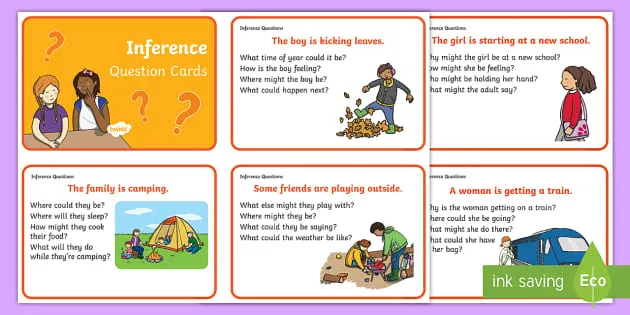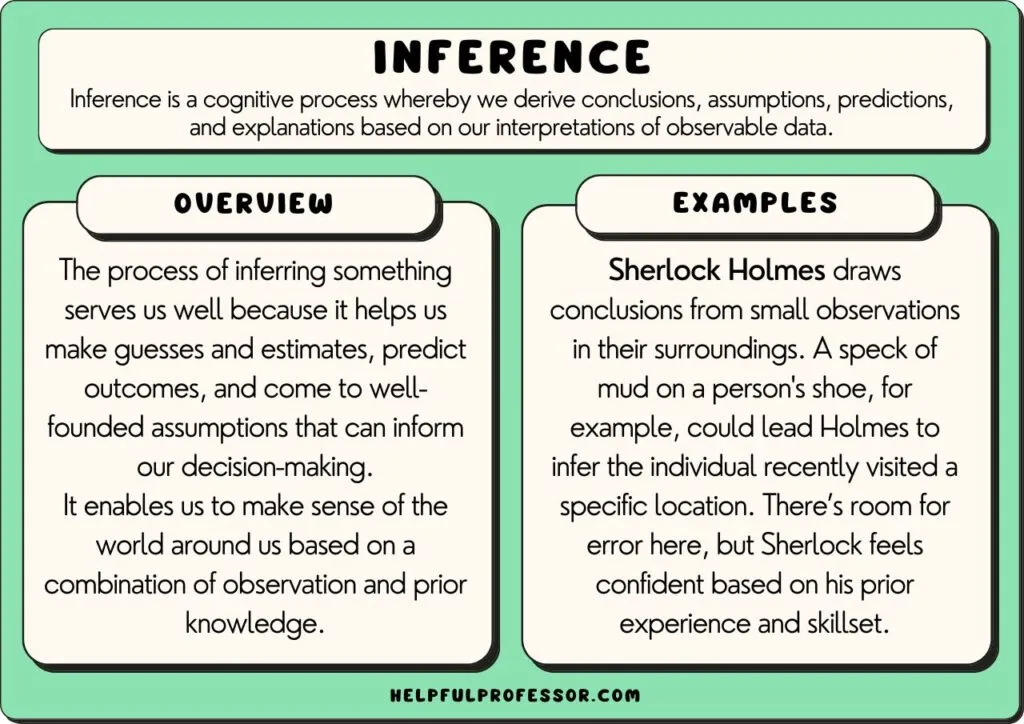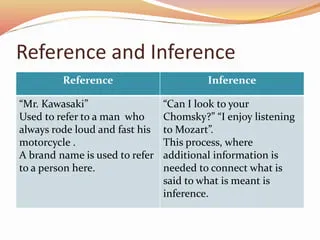Ever wondered how we grasp meanings beyond words? Join us as we delve into inference and reference, two key concepts that shape our communication. Discover how inference helps us draw conclusions from clues, and how reference allows us to point to specific things or ideas. By the end of this article, you’ll have a clearer understanding of these tools and how they enhance our everyday interactions. Improve your communication skills with these insights!
Table of Contents
The Relationship Between Inference and Reference
A speaker or writer sometimes uses one thing to refer to another and expects his listener/reader to make the connection between the two things. Often, things are used to refer to people and personal names like John, Uche or Ola can refer to things based on some associations. A student once told a classmate: “I lost my Stone and Cozens’” and the addressee immediately understood that “Stone and Cozens” was a Biology textbook.

Here the names of the authors are used to refer to their workWork is The transfer of energy from one physical system to a... More in a College context. Similarly, speaker/hearers do make some inferences or assumptions which generally enable them to interpret meaning correctly. In this article, we shall be looking at how reference and inference help speakers/writers communicate their intentions to their hearer/readers.
Semantic Reference
One fundamental characteristics of human language is the phenomenon of “aboutness” i.e. we are able to talk about things not present in our immediate environment as well as things that are displaced in time and space. This is true of the fact that the significance of human language is found in the way utterances correspond to things or facts around us.
However, it is difficult to generalize this correspondence to “facts” or “truths” because not every linguistic sign has a corresponding object in the physical world. Verbs or prepositions for instance, that indicate actions and relationships do not have direct physical references. The types of words or phrases that formally display references are demonstratives and indexical words as we saw in the last two units.
Semantic reference is a type of verbal or written “pointing to” or identifying (picking out) of certain objects or individuals that a speaker wishes to talk about. Earlier studies in semantics argue that the meaning of a word or sentence is intimately connected to the truth value of the sentence; hence reference is what relates words to the world of objects on whose condition truths relies on. Ferdinand de Saussure in his sign theory of meaning had contended that the linguistic sign is made up of a signifier (the word) and the signified(the object) and both are linked by a psychological associative bond (Palmer, 1996). Ogden & Richard (1923) conceives this relationship as a triangle, thus:

The symbol is the word or sentence; referent is the object (in the external world). Thought/reference is the concept. There is no direct link between the symbol and referent. The link is through the thought or reference (i.e. the concepts of our minds). Reference is therefore the object that the mind conceives about the entity which the word expresses or refers.
Thus the referent of the word chair is an object with four legs for sitting. This forms the basis of the proposition by philosophers like Russell and Frege that reference contributes to the truth and falsity of a statement. But we know that not all words have obvious referents in the physical world, (e.g. Christmas, liberty, love etc) and again several expressions may even refer to one referent but to avoid this limitation, semanticists use the terms denotation and connotation to differentiate between direct reference and extensionExtension is an expansion in length of an elastic spring as ... More.
Pragmatic Reference
Talking about semantic theory, those that argue that reference determines truth or falsity (e.g. Russell and Frege) fail to realise that if semantic reference characterizes the meaning of words and sentences in a general sense, there is another kind of meaning which results from producing and understanding the actual utterance and intention of the speaker, in which case we cannot talk about direct reference of some particular words in the sentence.
What we may even refer to as truth or falsity of the words or expressions turns out to be pragmatic rather than semantic. If we say that reference of a word or phrase is what contributes to the truth or falsity of a sentence, we notice that there are other words and expressions in the same sentence that do not have direct references but play a role in determining the truth or falsity of the sentence, so we talk of functions rather than reference.
Strawson argues that truth or falsity is a property of theuse of a sentence via an utterance in a particular context. He further points out that a verb such as ‘refer’ or ‘mention’ is a verb of doing because if you say x refers to y, rather than the general reference, there may be a specific reference which the speaker has in mind in which case the truth depends on the speaker and the context of the utterance.
If at a general level we talk of x (e.g. the ruling party) referring to y (PDP) in the Zambian context, there may be another context where x (the ruling party) does not refer to PDP. So rather than asked what y refers to generally (semantic reference) we should rather asked what you are referring to as y (pragmatic reference).
In fact in some cases, some references do not even refer to anything at all even though they have meaning from a semantic point of view. If you say “the skinny woman” you may be referring to a particular woman on one occasion and another in another occasion, but semantically there is no particular individual because there are many skinny women in the world. Take your mind back to our discussion on deictic references.
Intentions
Now the question is does reference always represent the speaker’s intensions? Does an error of reference nullify the speaker’s intention? Does a hearer always recognise the speaker’s reference as his/her intentions? Bach (1992) argues that “best of intentions” are good enough, i.e. demonstrations do not have semantic significance. For example if there are two mobile phones on the table and I point at one of them and say: “that’s my phone” and went on to pick the wrong one in error, the argument is that the mistaken demonstration does not affect reference, my intention to refer to my own phone still holds.
Referential intentions are such that should be recognised and that the hearer is able to recognise the reference as well as the intention. One’s reference in the above example is not fixed by one’s belief; it is fixed by the intention to refer and the intention that it be recognised as such (Carlson, 2006). Take another example; you are sitting in my office facing me. On the wall behind me is usually a picture of a cat. Unknown to me someone had replaced the picture with the picture of a human baby.
As we discuss, I pointed backwards (behind me and in front of you) and say to you: “that cat is a young bobcat.” My belief is that the picture behind me is that of a bobcat and the intention is to refer to the picture of a cat on the wall. You are to recognise my intention, however through my gesture. I have said something false despite my belief that I was saying something true. My intention to refer to a cat is not the relevant intention here.
What is rather available is the picture of a human baby. Since having intentions is not a property of language but that of speakers and listeners that may be carried out or indicated by action, pointing has no semantic relevance. Listeners are often able to workWork is The transfer of energy from one physical system to a... More out the speakers’ intentions despite errors in pointing. The most important thing therefore is that the listener understands the speaker’s intention even when reference indicated by gestures fails.
Inference
Inference is the process of working out the meaning or the intention of the speaker from the text or utterance available to you. This deductive process is usually based on some background knowledge of the context/shared understanding of values, social conventions or beliefs between the speaker and the hearer. Hearers or readers are always faced with the task of working something out and making explicit what is meant from what is not said or written.

If someone tells you: once again, I’ve lost valuable property in an air crashCrash is a serious accident (usually involving one or more v... More, you are likely to infer that: the person had been in an air crashCrash is a serious accident (usually involving one or more v... More before or that he is not likely to travel by air anymore. You’re inference however doesn’t have to be correct all the time, but that you are attempting to make an additional interpretation of an utterance is normal. Even in the readingA Reading on a measuring instrument or tool in physical scie... More of literary texts, we make plenty of inferences in terms of facts we take for granted and aspects of culture/social knowledge without which a text becomes difficult to appreciate.
We can infer the illocutionary forceIn physics, a force is any influence that causes a free body... More of an utterance that seems indirect and also infer that a conversational principle has been violated. According to Horn (2006), speakers implicate while the hearer infers.
CONCLUSION

We can see that reference, inference and intention have one common goal, i.e. successful communication. When we refer to things, we are either attempting to identify a particular thing by direct reference using some particular words or we are referring to things using not only words but also by actions, e.g. pointing, which the context enables our hearer to identify.
Very often we have had to workWork is The transfer of energy from one physical system to a... More out the meaning of utterances by inferring to certain dimensions of meaning relevant to the context which the utterance draws upon. All of these are geared toward arriving at the speaker’s intention. Linguistic pragmatics is essentially about how speakers and hearers are able to communicate effectively without always relying on what is explicitly expressed in words but by a combination of other factors such as utterance, behaviour, context, culture etc.
Understanding inference and reference is crucial for effective communication. They allow us to convey meaning beyond the literal words we use.
